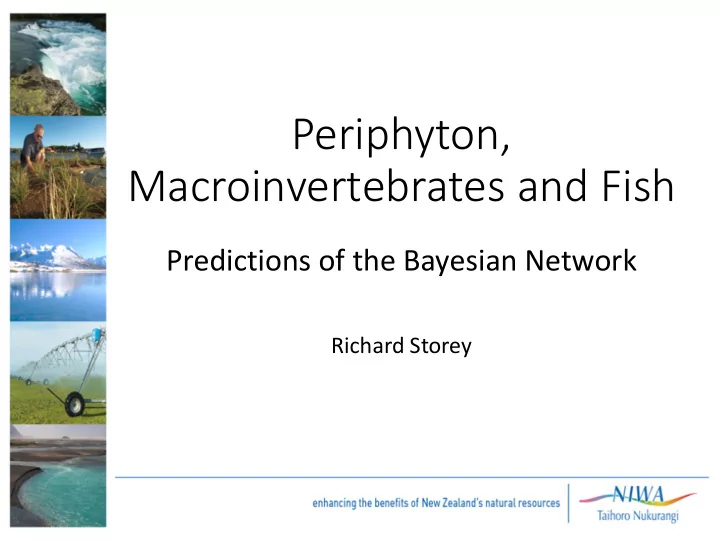

Periphyton, Macroinvertebrates and Fish Predictions of the Bayesian Network Richard Storey
Reporting reaches • 10 reaches • Each 6-9 km long • Large (4 th order or larger) • No small tribs
Periphyton Determined by: • Dissolved nutrients • Light at the riverbed • Summer water temperature • Frequency of flooding • Grazing invertebrates • Based on a national dataset. • Assume periphyton in Ruamahanga rivers responds to these drivers as it does in other places • Emphasis on relative results and changes, not absolute values
Periphyton: what the results mean • Probabilities of being in NOF bands A-D • NOF band means periphyton biomass doesn’t exceed this amount >1x/year in monthly samples. NOF band Periphyton biomass (mg Chlorophyll a per m 2 ) 50 A B 50-120 C 120-200 D >200
Periphyton Probability 100% 50% 0% Huangarua Baseline BAU Silver Gold Kopuaranga Baseline BAU Silver Gold Mangatarere Baseline BAU Silver Gold Rua @Pukio Baseline BAU Silver Gold Rua @TeOreOre Baseline BAU Silver Gold Baseline Taueru BAU Silver Gold Tauherenikau Baseline BAU Silver Gold Waingawa Baseline BAU Silver Gold Waiohine Baseline BAU Silver Gold Waipoua Baseline BAU Silver Gold 0 50 100 150 200 250 300 350 400 450 periphyton biomass (mg Chl-a / m2) RSOE D C B A
Periphyton Changes due to • Reductions in dissolved nutrients • Decrease in water temperature & light (Taueru only) Further reductions • >50% reduction possible in Kopuaranga and Mangatarere • smaller reductions possible in Ruamahanga, Waiohine and Taueru • By further decreasing dissolved nutrients • Hard to increase flood frequency, stream shade, hard to predict change in invertebrate grazers
Macroinvertebrate Community Index (MCI) Determined by: • Periphyton • Deposited silt • Water temperature • Low flow (MALF) • Based on a national dataset. • Assume MCI in the Ruamahanga catchment responds to these drivers as it does in other places • Emphasis on relative values and changes, not absolute values
MCI: what the results mean • Probabilities of being in condition bands excellent, good, fair, poor • Based on one sample per year. Condition band MCI score >120 Excellent Good 100-120 Fair 80-100 Poor <80
MCI Probability 100% 50% 0% Huangarua Baseline BAU Silver Gold Kopuaranga Baseline BAU Silver Gold Mangatarere Baseline BAU Silver Gold Rua @Pukio Baseline BAU Silver Gold Rua @TeOreOre Baseline BAU Silver Gold Baseline Taueru BAU Silver Gold Tauherenikau Baseline BAU Silver Gold Waingawa Baseline BAU Silver Gold Baseline Waiohine BAU Silver Gold Waipoua Baseline BAU Silver Gold 0 20 40 60 80 100 120 140 MCI score RSOE poor fair good excellent
MCI Changes are minimal because: • Deposited silt depends only on flood frequency (doesn’t change) • Summer water temp changes little except at Waipoua (up to 2 °C) • Periphyton changes at only 3 sites • Weak relationship with low flow (MALF)
Trout size and abundance Max size determined by • Invertebrate prey density • Water temperature • Water clarity Abundance determined by • Habitat area at low flow • Spawning habitat condition • Dissolved oxygen • Based on bioenergetic models and national surveys • Maybe key habitat characteristics not included • No local data available • Emphasis on changes at sites, not absolute values
Probability 100% 50% 0% Huangarua Baseline BAU Silver Gold Kopuaranga Baseline BAU Trout size and abundance Silver Gold Mangatarere Baseline BAU Silver Gold Rua @Pukio Baseline BAU Silver Gold Rua @TeOreOre Baseline BAU Silver Gold Baseline Taueru BAU Silver Gold Tauherenikau Baseline BAU Silver Gold Waingawa Baseline BAU Silver Gold Waiohine Baseline BAU Silver Gold Waipoua Baseline BAU Silver Gold poor med good
Trout size and abundance Results low and changes minimal because: • Water temperature high (>16 °C) and little change at many sites • Visual clarity: low (<1.4 m) and little change at all sites • Trout prey : low (e.g. <10%) and little change (bc little change in deposited silt, water temp, flood freq) • Habitat area: high and little change (except Huangarua)
Native fish: IBI Determined by • Migration barriers • Cover (veg, bank overhangs) on edge of channel • Amount of deep pools and runs • Deposited silt • BN developed for Ruamahanga rivers • IBI based on presence-absence, not abundance • IBI depends on native and exotic (pest) species • Classes (good, med, poor) are equal thirds from range of actual values in Wellington region.
Probability 100% 50% 0% Native fish: IBI Huangarua Baseline BAU Silver Gold Kopuaranga Baseline BAU Silver Gold Mangatarere Baseline BAU Silver Gold Rua @Pukio Baseline BAU Silver Gold Rua @TeOreOre Baseline BAU Silver Gold Baseline Taueru BAU Silver Gold Tauherenikau Baseline BAU Silver Gold Waingawa Baseline BAU Silver Gold Waiohine Baseline BAU Silver Gold Waipoua Baseline BAU Silver Gold lower third middle third upper third
Probability 0.5 0 1 Native fish: 3 species Huangarua Baseline BAU Silver Gold Kopuaranga Baseline BAU Silver Gold Mangatarere Baseline BAU Silver Gold Rua @Pukio Baseline BAU Silver Gold Rua @TeOreOre Baseline BAU Silver Gold Baseline Taueru BAU Silver Gold Tauherenikau Baseline BAU Silver Gold Waingawa Baseline BAU Silver Gold Waiohine Baseline BAU Silver Gold Waipoua Baseline BAU Silver Gold Eels Inanga Redfin bullies
Native fish: IBI, eels, inanga, RF bullies Minimal changes because: • Changes to flood protection works outside scope • Bank edge cover sufficient at baseline in all sites except Waingawa • Deposited silt depends only on flood frequency (doesn’t change) • No migration barriers Note: • large rivers only • presence-absence, not abundance
Summary • Periphyton: small improvements at 3 sites • MCI: all sites “fair”; no signif. change • Trout: 2 sites med, rest poor; no change • Native fish: • IBI high; change at 1 site • Eels, inanga, RF bullies probably present; change at 1 site
Recommend
More recommend